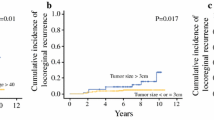Abstract
Background
Locoregional recurrence (LRR) after mastectomy reduces the patient’s quality of life and survival. There is a consensus that postmastectomy radiotherapy (PMRT) helps establish locoregional control and reduces LRR in patients with ≥4 metastatic nodes. However, in patients with 1–3 metastatic nodes, the incidence of LRR and the role of PMRT have been the subject of substantial controversy. This study assessed the risk factors for LRR and the efficacy of PMRT in Japanese breast cancer patients with metastatic nodes.
Methods
This study analyzed 789 cases of invasive breast carcinoma with metastatic nodes from 1998 to 2008. We divided the study population into 4 groups: 1–3 positive nodes with/without chemotherapy and ≥4 positive nodes with/without chemotherapy. Risk factors for LRR were identified and the relationship between LRR and PMRT was analyzed.
Results
During the median follow-up of 59.6 months, 61 (7.7%) patients experienced LRR. In patients who received chemotherapy, independent LRR risk factors were high nuclear grade, severe lymphatic invasion, vascular invasion, and progesterone receptor-negative status in patients with 1–3 positive nodes, and severe lymphatic invasion and estrogen receptor-negative status in patients with ≥4 nodes. Although patients treated with PMRT had good outcomes, there was no significant difference, and PMRT did not significantly improve the outcome of the patients with all risk factors.
Conclusions
With systemic therapy and adequate dissection, PMRT by itself was of limited value in establishing locoregional control. The indication for PMRT in patients with 1–3 positive nodes remains controversial.




Similar content being viewed by others
References
Overgaad M, Hansen PS, Overgaard J et al (1997) Postoperative radiotherapy in high-risk premenopausal women with breast cancer who receive adjuvant chemotherapy. N Engl J Med 337:949–955
Ragaz J, Jackson SM, Le N et al (1997) Adjuvant radiotherapy and chemotherapy in node-positive premenopausal women with breast cancer. N Engl J Med 337:956–962
Olson JE, Neuberg D, Pandya KJ et al (1997) The role of radiotherapy in the management of operative locally advanced breast cancer: results of a randomized trial by the Eastern Cooperative Oncology Group. Cancer 79:1138–1149
Pierce LJ (2006) The use of radiotherapy after mastectomy: a review of the literature. J Clin Oncol 23:1706–1717
Katz A, Strom EA, Buchholz TA et al (2001) The influence of pathologic tumor characteristics on locoregional recurrence rates following mastectomy. Int J Radiat Oncol Biol Phys 50:733–742
Overgaard M, Nielsen HM, Overgaard J (2007) Is the benefit of postmastectomy irradiation limited to patients with four or more positive nodes, as recommended in international consensus reports? A subgroup analysis of the DBCG 82 b&c randomized trials. Radiother Oncol 82:247–253
Truong PT, Olivotto IA, Whelan TJ et al (2004) Clinical practice guidelines for the care and treatment of breast cancer: 16. Locoregional post-mastectomy radiotherapy. CMAJ 170:1263–1273
Marks LB, Zeng J, Prosnitz LR (2008) One to three versus four or more positive nodes and postmastectomy radiotherapy: time to end the debate. J Clin Oncol 28:2075–2077
Goldhirsch A, Glick JH, Gelber RD et al (1998) Meeting highlights: international consensus panel on the treatment of primary breast cancer. J Natl Cancer Inst 90:1601–1608
Goldhirsch A, Glick JH, Gelber RD et al (2001) Meeting highlights: international consensus panel on the treatment of primary breast cancer. J Clin Oncol 19:3817–3827
Goldhirsch A, Wood WC, Gelber RD et al (2003) Meeting highlights: updated international expert consensus on the primary therapy of early breast cancer. J Clin Oncol 21:3357–3365
Goldhirsch A, Glick JH, Gelber RD et al (2005) Meeting highlights: international expert consensus on the primary therapy of early breast cancer 2005. Ann Oncol 16:1569–1583
Goldhirsch A, Wood WC, Gelber RD et al (2007) Progress and promise: highlights of international expert consensus on the primary therapy of early breast cancer 2007. Ann Oncol 18:1133–1144
The World Health Organization (1983) The World Health Organization histological ty** of breast tumors second edition. Am J Clin Pathol 78:806–816
Elston CW, Ellis IO (1991) Pathological prognostic factors in breast cancer. I. The value of histopathological grade in breast cancer: experience from a large study with long-term follow-up. Histopathology 19:403–410
The Japanese Breast Cancer Society (2008) General rules for clinical and pathological recording of breast cancer, 16th edn. Kanehara, Tokyo (in Japanese)
Tsuda H, Akiyama F, Kurosumi M et al (1998) Establishment of histological criteria for high-risk node-negative breast carcinoma for a multi-institutional randomized clinical trial of adjuvant therapy. Jpn J Clin Oncol 28:486–491
Katz A, Strom EA, Buchholz TA et al (2000) Locoregional recurrence patterns after mastectomy and doxorubicin-based chemotherapy: implication for postoperative irradiation. J Clin Oncol 18:2817–2827
Wallgren A, Bonetti RD, Gelber RD et al (2003) Risk factors for locoregional recurrence among breast cancer patients: results from international breast cancer study group trials I through VII. J Clin Oncol 21:1205–1213
Nielsen HM, Overgaard M, Grau C et al (2006) Loco-regional recurrence after mastectomy in high-risk breast cancer-risk and prognosis. An analysis of patients from the DBCG 82 b&c randomization trials. Radiother Oncol 79:147–155
Yildirum E (2009) Locoregional recurrence in breast carcinoma patients. Eur J Surg Oncol 35:258–265
Taghian A, Jeong JH, Mamounas E et al (2004) Patterns of locoregional failure in patients with operative breast cancer treated by mastectomy and adjuvant chemotherapy with or without tamoxifen and without radiotherapy: results from five national surgical adjuvant breast and bowel project randomized clinical trials. J Clin Oncol 22:4247–4254
Kyndi M, Sørensen FB, Knudsen H et al (2009) Response to postmastectomy radiotherapy in high-risk breast cancer: the Danish breast cancer cooperate group. J Clin Oncol 26:1419–1426
Conflict of interest
None.
Author information
Authors and Affiliations
Corresponding author
About this article
Cite this article
Nagao, T., Kinoshita, T., Tamura, N. et al. Locoregional recurrence risk factors in breast cancer patients with positive axillary lymph nodes and the impact of postmastectomy radiotherapy. Int J Clin Oncol 18, 54–61 (2013). https://doi.org/10.1007/s10147-011-0343-y
Received:
Accepted:
Published:
Issue Date:
DOI: https://doi.org/10.1007/s10147-011-0343-y




